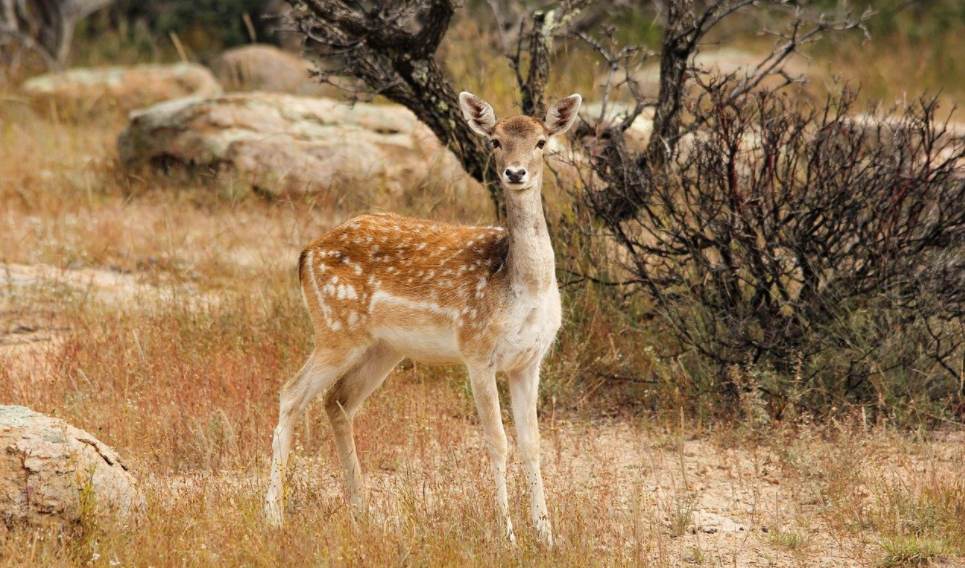Are you a passionate deer hunter or a person who is just interested in these magnificent animals? Do you ever confuse yourself as to why you are unable to find them even when you are pretty much certain they are around? The answer might just be the difference in point of view. Deer, unlike people, are differently oriented in color vision. It will either enhance your deer hunting potential or just feed your curiosity to know if deer can see red light and how they perceive colorful things.
This guide will tell you how deer’s vision is different from human’s vision what kinds of colors it can distinguish and which ones it cannot. For hunters and people with an interest in nature, it is very useful.
Deer Vision vs Human Vision
Deer eyes have several adaptations that allow them to excel in their natural environment. Here’s a breakdown of deer vision and how it compares to human vision.
Deer Vision
- Large pupils: Deer possess fairly large irides that can also widen in conditions where light levels are minimal. This enables them to get more light and have a better view at night or in the early morning and evening times.
- Large Retinas: The retinal surface area in deer eyes is larger than that in human eyes, and thus provides wider visual spectra. This is helpful for them to identify movements and creatures that may pose threats from a distance.
- High Sensitivity to motion: Deer have one of the most sensitive motion detectors among all large mammals. This enables them to be able to identify such factors as the movement of a predator or a food source and act appropriately.
- Tapetum Lucidum: There is a reflective layer just behind the retina known as the tapetum lucidum that aids their vision in the dark by bouncing light to the photoreceptor cells. This enables them to have better vision at night they what we humans can see during the same period of the night.
- Color Vision: Deer cannot distinguish red from green but can differentiate between blue and yellow. These differences can be attributed to their evolution and the kind of foliage they feed on in the wild.
How Is Deer Vision Different From Human?
Deer have much better night vision than people because of a larger pupil, a larger retina, a reflective layer called the tapetum lucidum, and higher sensitivity to movement.
And, deer are capable of seeing more than humans can and this gives them a wider angle of vision.
The major difference is that deer have NO red-green color vision while humans have complete color vision.
Despite the existing differences in the details of deer vision, most of the deer species experience the general vision adaptations discussed above. There may be slight differences in the size of their pupils, retinas, and sensitivity to motion, depending on the habitat and lifestyle.
Are Deer Color Blind?
Yes, deer are known to be color blind in the sense that they cannot distinguish between the color red and the color green.
This infers that they are unable to differentiate between these colors. However, they can distinguish blue and yellow, which is quite enough to navigate through the wildlife environment.
What Colors Can Deer See?
1. Can Deer See Red Light?
Deer are unable to distinguish or even recognize a red color light. Its color perception is relatively poor, and it is almost completely red-green blind and can only perceive shades of blue and yellow. This may be an adaptation to their surroundings, as the colors red and green are also present in plant life.
- Daytime: Deer may be non-discriminative towards red light as a color during the day or in well-lit afternoons/ evenings.
- Nighttime: Red light may be less conspicuous to deer at night because their perception of light is considerably weaker during the night. However, this does not rule out the chances completely, as there will still be some deer who might be able to detect it.
2. Can Deer See Orange?
Yes, deer can see orange. It falls within their visible spectrum, which includes blue, yellow, and orange. However, because deer are color-blind to red, they may not perceive orange as strongly as humans do.
While deer may not be as sensitive to orange as we are, it’s still a good idea for hunters to wear hunter-orange clothing to increase visibility and reduce accidental shootings. The bright color helps distinguish humans from other animals in the woods.
3. Can Deer See Green Light?
No, deer cannot see green light. Similar to red, green is outside of their visible spectrum.
4. Can Deer See Blue?
Yes, deer can see blue. Blue is one of the colors they can perceive, along with yellow.
5. Can Deer See Black?
No, deer cannot see black. Black is the absence of light, so it is not a color that can be seen. However, they can perceive dark objects due to their sensitivity to light and shadows.
6. Can Deer See Pink?
No, deer cannot see pink. Pink is a combination of red and white, and since deer cannot see red, they cannot perceive pink.
7. Can Deer See Yellow?
Yes, deer can see yellow. Yellow is one of the primary colors they can perceive, along with blue. This is likely an adaptation to their environment, as yellow is a common color in many plants and flowers.
What Colors Can Deer Not See?
All in all, deer cannot see red light, green, and black and they are also less sensitive to orange colors. This means they may perceive these colors as gray or brown.
Therefore, while they can see a range of colors, red and orange are colors that deer often have difficulty distinguishing.
Can Deer See In The Dark?
Deer are virtually blind during the day but they have extraordinary vision during the night. They have bigger pupils and a reflective layer at the back of the eye, called the tapetum lucidum that enables them to collect more light. This makes them have better vision in the dark as compared to human beings.
As for how far a deer can see, it depends on several factors, including.
Light conditions: Variation of light intensity will determine the extent of vision range that a deer will have.
Object size and contrast: Deer targets large, highly contrasting objects easily due to its visibility from a farther distance.
Deer’s age and health: The eyesight will also vary depending on the age and health of the deer; for instance, a young, healthy deer will have better eyesight than a diseased or old deer.
In general, deer have a night vision that enables them to perceive objects almost up to a range of 500 yards. However, they may be capable of detecting larger objects like predators or human beings from even greater distances.
Conclusion
Deer cannot see red light though they are aware of colors.
Knowledge of this deer’s eyesight may be of great benefit to hunters and anyone who loves nature and wants to observe deer closely. It can also be useful in developing better hunting practices by staying away from colors visible to deer.
However, their excellent vision and response to movement during the night establish them as more suitable animals within their natural habitat. It is important to look at these aspects to increase the knowledge about the nature of these beautiful creatures and the way they operate.





















Leave a reply